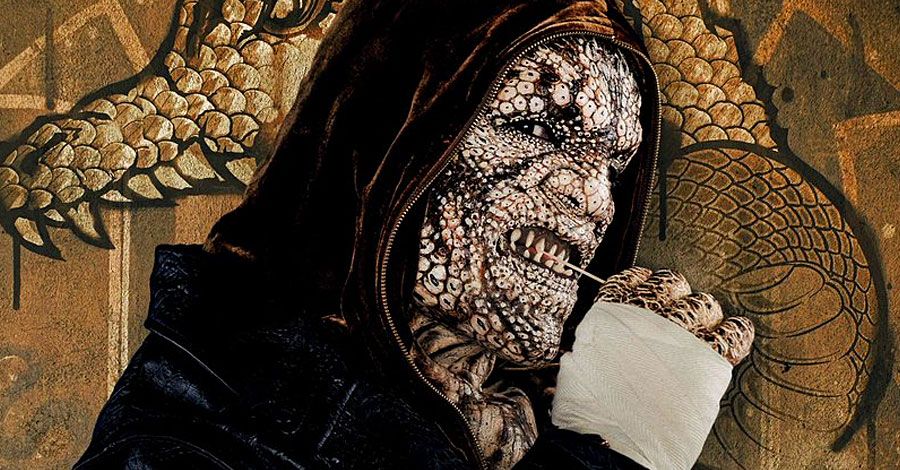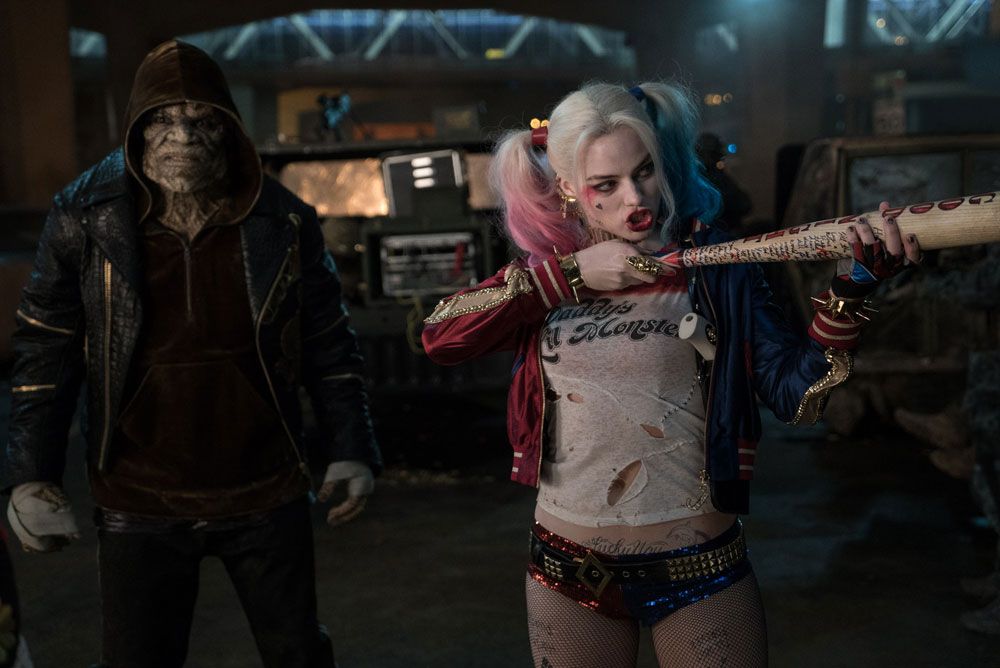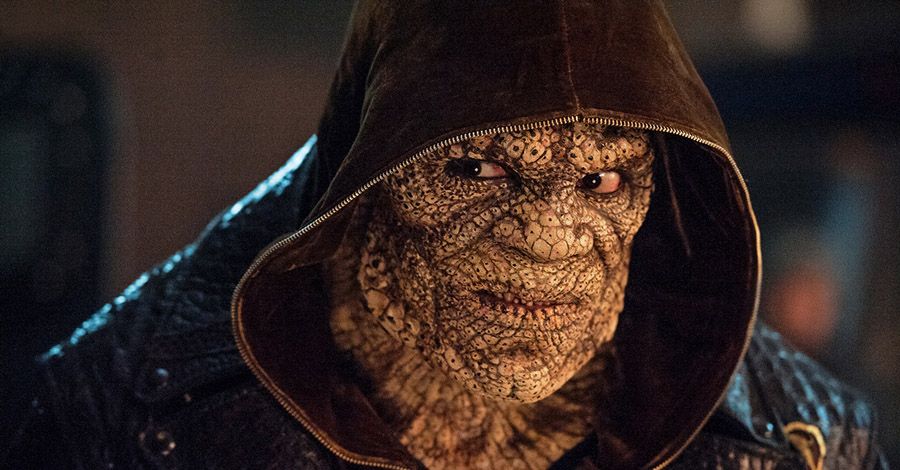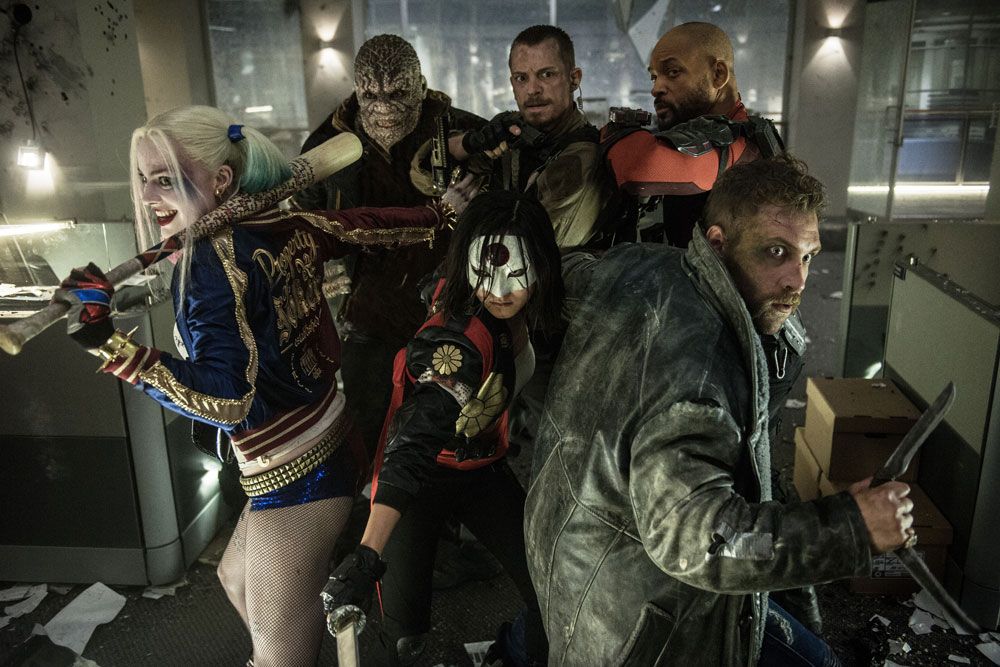Killer Croc may be a sewer-dwelling loner with a taste for human flesh, but Adewale Akinnuoye-Agbaje insists that beneath his scaly exterior, "Suicide Squad's" resident reptilian cannibal only wants to be loved.
"There are some beautiful moments in the movie -- tender moments, and unpredictable moments, and gentle moments, humorous moments," he shared with a small group of journalists, including CBR News, on the Toronto set of director David Ayer's film. "And those are all whispers of who he was as Waylon Jones."
Best known for his roles in "The Bourne Identity," "Lost" and "Oz," Akinnuoye-Agbaje also discussed the arduous makeup and prosthetic process, and researching alligators and real-life cannibals to prepare for what he describes as one of the most challenging roles of his career.
Talk about the makeup process. Did you know what you were going to get into with that?
Adewale Akinnuoye-Agbaje: To answer your question first, no, I didn't. It was a huge leap of faith. Obviously, David Ayer, Warner Bros., "Suicide Squad" -- the whole package was very attractive. After having a few conversations with David about what he wanted to do, and how real-based he wanted to make it, I was excited for that.
But literally did I know what? Absolutely not. I didn't actually read the script until we signed on. That was the process. But what is that process? The process is very, very interesting and arduous. First of all, I have probably one of the most amazing prosthetic teams in the business, Chris Nelson and the guys in LA. They've created, as you'll see today, the most amazing prosthetic lifeform in the form of Killer Croc.
What that does for me, it just enables me to really bring him to life. I mean I've done this before, but never to this degree. The detail, the proportions, how real I can make it -- it literally follows every crease on my face. But the actual process of getting into it, putting it on? On some days, when I'm just doing head and shoulders and the hands, it's about three hours. But there will be the last section of the movie where I'm going to be fully body. That's going to be about five, six hours.
Have you found a way to perform through it, to have your face, your emotions come through that plastic prosthetic?
It was a very real concern of mine when first approached about the project. I said to David, "Am I going to be recognizable?" He said, "Absolutely yes." I think, for me, the challenge was, and still is, is to really displace the fact that I am wearing prosthetics for the audience, and really have the audience relate to the soul of this creature or hybrid, this creature/man. That's my challenge. That's what both me and David were aiming for -- the soul of this creature -- and not rely on prosthetics.
To that end, as I've said, I've been helped with the amazing look at it, because it feels very real. It's literally glued onto my face. So, every movement, I played around with it quite a bit in the mirror before I went to camera. I tried to get the right motions. So that was really important.
One of the decisions that the director and I both agreed on was the non-use of contact lenses because it allows the viewer to really -- you know, with the eyes being the window of the soul -- it really allows them to connect with him, especially Croc or Waylon Jones, who he formerly was, with that part of him, that human part of him. And you feel this human trapped in this creature's body.
So not having, initially, the contacts. Now, what they do with them later, I don't know, but that was our initial talks. But not having that was very important for you to be able to connect with the soul of the creature. That's my challenge, is to make him as real as possible. Both David and I, we talked extensively about the look. Obviously, there is a huge backlog of history and story of how he looks. But this was the first reincarnation of him in film. And David was very insistent on making it very real.
The color, you'll notice, is my own skin tone, so that you can see the graduation of this disease that he has. So you'll see it meshed in with my own skin into the scales of what he later becomes, which is Killer Croc.
There were different colors and shades, but again, wanting to keep it very real and very almost like this is a man that became a croc or inhabited crocodile features. He's not a crocodile, he's a man. So we wanted to show that in as many aspects as we could, from the skin tone, to not using the lenses, and even to his attire. We talked about how he was going to be dressed and living in the sewer and underground.
But again, in the world of Gotham, this is a supervillain that was really going toe to toe with Batman and about to take over. After we really analyze and evaluate that history, it was like, "Well, he wouldn't really just be hiding simply under there depressed." He's owning that world.
So he's had that history with Batman when we first see him in the film. That's in the past?
I'm not going to give too much away. I want you to go and see that for yourself. You know the history from the comic books. What's in the movie I'll leave for you to see.
It's not an origin story for him. He has a history ...
No, no ...
That's what I was asking.
Later on you'll see that. But no, it's not an origin story. It was very important for David and I to have him celebrate that world and literally reign in the sewer. That is his kingdom, the underground that comes over.
You touched on it a little bit, but what, as an actor, do you even pull from the process of getting transformed into him? What do you pull from that into the character itself?
That's a very good question. I remember when we were doing the rehearsal process with David. And I asked David, I said, "I've been doing all this reading and I know he's inhabiting crocodilian habits and features. But does he really eat people?" He said, "Yes." He said, "He's a cannibal." And right there was my answer, because when you eat human flesh, first of all, it's a taboo that you can never go back from. And it takes you to a certain level within yourself as a human, a darker side.
So when you ask me how do I go into that character, that is really my go-to kind of key. And I did a lot of research on cannibalistic habits from back to the Mayans and the Aztecs, right up to modern-day cannibals. There's this guy that I'd play every single day, and I had it right on my phone. It's a Japanese cannibal, Issei Sagawa, who ate a French model.
As sick as it sounds, the moment I start to play that video, I'm in the form of Croc, because it's really important for this creature to be thirsty for flesh, even when he's around the Squad. They always have to be wary and be aware of the fact that, at any moment, he might get the hunger and just take an arm off. Does he do it because he likes it? Does he do it to send a message to his enemies, like instill fear? Whatever reason he does it, he does do it. So that was my go-to.
And I went down to the Everglades and I hung out with alligators and stuff. I went down to the swamps and watched them, took video of them, saw how they moved. And you'll notice that how [Croc] moves is really when the prosthetics came alive, because I tried the different stances, but the moment I started to embrace the movement of walking through water, even though it was on land, really inhabiting the moves of a crocodile, the prosthetics just came alive. And it had a very reptilian characteristic about it, just from the swaying. That's a very definitive characteristic that I just put in there to make, again, people realize that he's an animal. So he sways like that. Even when he's still, his head's always as if it's in water.
Those are some of the things that take me in to cannibals. It's not a pretty thing, but it gets me there. And also, I've made a distinct and concerted effort to actually keep away from the rest of the Squad. Because he lives underground, because he's a loner, because he's nocturnal, and because they have to be wary of him at all times, I've had to inhabit that through the process.
The character you described is he's ready to flip on anyone. Is there a side to the character that is more human and maybe would not like to be thirsting for human flesh?
I think so. I mean, definitely. If you look back into his backstory, he's a boy that's been tortured, humiliated, ostracized, ridiculed.
His backstory in the comics or in this movie?
Waylon Jones, his backstory in the comics. Obviously, my research, that's what I used to kind of establish who Waylon was as an adult. Ultimately, and with any of the characters you will notice this, but ultimately in Croc, he just wants to be loved. But because he's been ostracized, he's made that work for him.
But you'll see. There are some beautiful moments in the movie -- tender moments, and unpredictable moments, and gentle moments, humorous moments. And those are all whispers of who he was as Waylon Jones. But certainly the pain and the loneliness, you can see it in his eyes. There are decisions that he has to make along the journey whether he's going to continue that solo, lonesome thing, or is he going to find a family? It's a big moment for him.
There are a couple of big moments in the movie where, for the first time, somebody that he's fighting doesn't actually judge him, doesn't care what he looks like. And it's a pivotal point for Croc, because everybody is always freaked out by how he looks. But this guy just wants to complete a mission. And that's a revelation for him.
The human aspect comes out along the journey just in bonding with the family. And I think at the very end of that journey you see that that's pretty much all he ever wanted, was to be accepted. You know what I mean? So the fact that he's had to go that way may not have been what he wanted, but just what he had to do because of the persecution.
But when people are not judging him and just accepting him, I think he's really actually in a good space. He probably wouldn't even eat them.
You're the muscle of this group. With all of the makeup and everything, how exhausting and tiring has this role been for you?
This has probably been one of the most challenging roles of my career. I tend to look at it like this: I think that every job that I've had up until this point has probably prepared me for this. Not just physically, but psychologically, because to stay in that dark space ... And also, Croc does speak. He has a Bronx accent, which is obviously another step removed from who I am.
There's no doubt about it. It is really, really an arduous task. There's no getting around it. Couple that with the prosthetics. I'm always the first in and always the last to leave. But it's just helped by the fact that I've got a great team of prosthetic artists around me. But there's no getting around it -- it's a tough nut to crack. But I think the ultimate rewards are what you are going to see up on the screen. You are going to see something that you've never seen before in prosthetics, a realism to it that you've not seen, and also an emotional level.
Because we see in all these superhero and supervillain movies, a lot of them are robotic or clunk around, but there's no humanity in it. There's no human content. You can't connect with them as a being. And you are going to see that come through, as well as the ferocity, the power, and all the other stuff that goes with being a super villain. Which, I think you are going to love him before you really get to hate him. You're going to love this guy. I think you are going to fall in love with this guy, man. Yeah, you are going to have little furry Croc, little Croc slippers. He's adorable. And he says in the movie, "I'm beautiful." He owns it.
I think, as an actor, to me I just felt that if I can act my butt off in this and make people like him as a being, then I've done a good job, and to forget about almost the fact that he's wearing this other stuff and just look at him as a being. Then I'm like, "All right. I'm done. I've ticked that box."
"Suicide Squad" opens Aug. 5.




